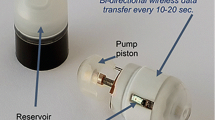Abstract
The concept of delivering systemically active peptide drugs to the colon in order to improve their oral absorption requires reasonable peptide permeability of the large intestinal wall and stability against the activity of the colonic microflora. In addition, the role of hepatic extraction needs to be addressed. In this study the absorption of the pentapeptide metkephamid following single pass perfusion of rat ascending colon was investigated by monitoring its disappearance from the large intestine and simultaneous appearance in the portal vein, the hepatic vein and the aorta. In addition its stability against colonic microflora was tested in vitro using pig caecal contents. Metkephamid was absorbed from the large intestine and appeared in the blood circulation; peptide concentrations in the portal vein increased over-proportionally with increasing perfusate concentrations (0.1 − 4.6 mmol/L) from 0.19 µg/mL ± 0.12 (SD, n = 7) to 31.6 µg/mL + 20.65 (SD, n = 4), respectively, and thus suggesting a saturable transport or metabolism. Concentrations in the hepatic vein were significantly lower than in the portal vein, hepatic extraction ratios were 0.35 ± 0.14, 0.61 ± 0.18 and 0.62 ± 0.28 (SD, n = 4) for 0.1, 0.5 and 1.0 mM metkephamid perfusate concentrations, respectively. In the anaerobic colon metabolism model the degradation half-life of the peptide was 14.9 hours, thus, indicating relative stability in the bacterial environment of the colon. The results of the present study encourage further investigations on colonic delivery of peptide drugs.
Similar content being viewed by others
REFERENCES
A. H. Kahns, H. Bundgaard. Prodrugs of peptides. 13. Stabilization of peptide amides against alpha-chymotrypsin by the prodrug approach. Pharm. Res. 8:1533–1538 (1991)
H. Bundgaard and G. J. Rasmussen. Prodrugs of peptides. 9.Bioreversible N-α-hydroxyalkylation of the peptide bond to effect protection against carboxypeptidase or other proteolytic enzymes. Pharm. Res. 8:313–322 (1990)
Miriam Kidron, Hanoch Bar-On, Elliot M. Berry, Ehud Ziv. The absorption of insulin from various regions of the rat intestine. Life Sci. 31:2837–2841 (1982)
S. S. Davis. Delivery systems for biopharmaceuticals. J. Pharm. Pharmacol. 44 (Suppl. 1):186–190 (1992)
P. Langguth, H. P. Merkle, G. L. Amidon. Oral absorption of peptides: The effect of absorption site and enzyme inhibition on the systemic availability of metkephamid. Pharm. Res. 11:528–535 (1994)
K. Ikesue, P. Kopeckova, J. Kopecek. Degradation of proteins by enzymes of the gastrointestinal tract. Proceed. Intern. Symp. Control. Rel. Bioact. Mater. 18, 580–581 (1991)
P. R. Bieck. Arzneistoffresorption aus dem menschlichen Dickdarm-neue Erkenntnisse. Act. Pharm. Technol. 33:109–114 (1987)
W. E. C. Moore, E. P. Cato, L. V. Holdeman. Some current concepts in intestinal bacteriology. Am. J. Clin. Nutr. 31, S33 (1978)
G. T. MacFarlane, G. R. Gibson, E. Beatty, J. H. Cummings. Estimation of short-chain fatty acid production from protein by human intestinal bacteria based on branched-chain fatty acid measurements. FEMS Microbiol. Ecol. 101, 81–88 (1992)
V. H. Lee. Oral route of peptide and protein drug delivery. Pharm. Tech. Int. 4:59–64 (1992)
R. A. Argenzio, N. Miller, W. Engelhardt. Effect of volatile fatty acids on water and ion absorption from the goat colon. Am. J. Physiol. 229:997–1002 (1975)
G. Breves, J. Dreyer. Continuous in vitro incubation as a model to study microbial metabolism in the hind-gut of pigs. Proc. Nutr. Soc. 50, 76A (1991)
G. Breves, J. Dreyer, H. J. Oslage. In vitro-studies on microbial hindgut metabolism in pigs. Adv. Animal Physiol. and Animal Nutr. 22, 89–92 (1991)
J. W. Faigle. Drug Metabolism in the colon wall and lumen. In: P. R. Bieck (ed.) Colonic Drug Absorption and Metabolism, Dekker, NY, 1993 pp. 29–54
S. A. W. Gibson, C. McFarlan, S. Hay, G. T. MacFarlane. Significance of microflora in proteolysis in the colon. Appl. Environ. Microbiol. 55:679–683 (1989)
G. T. MacFarlane, J. H. Cummings, S. MacFarlane, G. R. Gibson. J. Appl. Bacteriol. 67:521 (1989)
G. T. Macfarlane and J. H. Cummings. The colonic flora, fermentation, and large bowel digestive function. In. S. F. Philips, J. H. Pemberton, R. G. Shorter (eds.), The Large Intestine: Physiology, Pathophysiology, and Disease. Raven Press, New York, 1991, pp. 51–92
M. Bohe, A. Borgstrom, S. Genell, K. Ohlsson. Determination of immunoreactive trypsin, pancreatic elastase and chymotrypsin in extracts of human faeces and ileostomy drainage. Digestion 27:8–15 (1983)
A. Borgstrom, S. Genell, K. Ohlsson. Elevated fecal levels of endogeneous pancreatic endopeptidases after antibiotic treatment. Scand. J. Gastroenterol. 12:525–529 (1977)
K.-H. Antonin. Other methods in studying colonic drug absorption. In. P. R. Bieck (ed.) Colonic Drug Absorption and Metabolism, Dekker, 1993, pp. 29–54
D. Brockmeier, H. G. Grigoleit, H. Leonhardt. Absorption of glibenclamide from different regions of the gastrointestinal tract. Eur. J. Clin. Pharmacol. 29:193 (1985)
S. Lundin, N. Pantzar, A. Broeders, M. Ohlin, and B. R. Weström. Differences in transport rate of oxytocin and vasopressin analogs across proximal and distal isolated segments of the small intestine of the rat. Pharm. Res. 8:1274–1280 (1991)
S. Lundin, H. Vilhardt. Absorption of 1-deamino-8-D-arginine vasopressin from different regions of the gastrointestinal tract in rabbits. Act. Endocrinol. 112:457–460 (1986)
G. Fricker, J. Drewe, J. Vonderscher, T. Kissel, C. Beglinger. Enteral absorption of octreotide. Br. J. Pharmacol. 105:783–786 (1992)
A. Monosroi, K. H. Bauer. Effects of gastrointestinal administration of human insulin and a human insulin-DEAE-dextran complex entrapped in different compound liposomes on blood glucose in rats. Drug Dev. Ind. Pharm. 16:1521–1538 (1990)
P. S. Burton, R. A. Conradi, A. R. Hilgers and N. F. H. Ho. Evidence for a polarized efflux system for peptides in the apical membrane of Caco-2 Cells. Biochem. Biophys. Res. Commun. 190:760–766 (1993)
Author information
Authors and Affiliations
Rights and permissions
About this article
Cite this article
Langguth, P., Breves, G., Stökli, A. et al. Colonic Absorption and Bioavailability of the Pentapeptide Metkephamid in the Rat. Pharm Res 11, 1640–1645 (1994). https://doi.org/10.1023/A:1018974107844
Issue Date:
DOI: https://doi.org/10.1023/A:1018974107844




